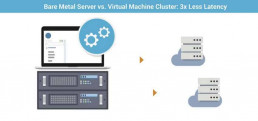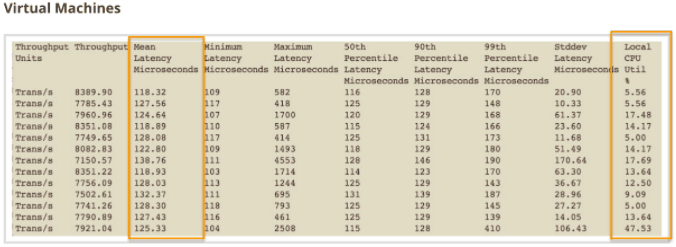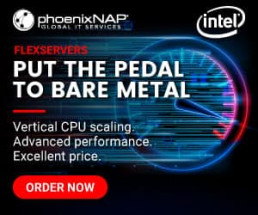Just because of the sheer volume of solutions out there, it is very challenging to generalize and provide a universally truthful answer to which is better, a bare metal or cloud solution. When you also throw in all the various use cases into the equation, you get a mishmash of advice.
However, we can all agree that each option has its advantages and disadvantages. In this article, I will try to provide an overview of strong points and shortcomings of both bare metal and cloud environments, with a single use case performance comparison.
Let us start with the pros and cons of a bare metal server.

Advanced Features of Bare Metal
Dollar for dollar, bare metal servers can process more data than any other solution. Just imagine 28 cores working their way through data, going as smooth as a knife through butter.
Of course, there are exceptions. If you are running a single-threaded application, it does not matter how much cores you throw at it; you will not see any benefit. To have your applications running in an optimal environment, you need to make sure you have chosen the right solution.
Single-tenant environment
It is kind of soothing to know that at any given point in time, 100 percent of a server’s resources are at your disposal. A bare metal or dedicated server is your private environment in that you can configure it any way you want.
In comparison, pick the wrong vendor for your public cloud solution, and you will feel like you are using public transportation – things will go slow, and you will not get anything done in time.
Another critical point is security, of course. Again, I will use the public transportation metaphor. Bare metal servers are like having your own car in the sense that you are isolated from the outer world, safe knowing that nobody can get in. Public cloud, on the other hand, can be like riding the bus, you never know who is getting on and whether someone will try to do something harmful.
Raw power and reliability
Picture Grand Tour host, Jeremy Clarkson, screaming “power” at the top of his lungs. Well, that is what you get with bare metal. It is fully customizable, and it ranges from state of the art powerhouses to inexpensive low-powered machines. If you are looking into dedicated bare metal, then you are in for it for the raw power of the latest and greatest CPUs, such as the Intel® Xeon® Scalable processors family. I am thinking something along the lines of a dual Intel® Xeon Gold 6142 (32 ×2.6GHz) 6-bay with 512 GB ECC DDR4 and additional SSD storage. I always say, if you want to overtake your competitors, you stand slim chances of doing it with a Ford Pinto.
Customization opportunities
You are the one who builds the configuration from the ground up and selects each component, so it is more than evident that bare metal provides ample room for customization. Besides hardware resources, you can have any operating system you like, or control panel, software option, and control panel add-on. You can even run your own environment with a virtualization hypervisor.
That brings us to an essential point.

You need to know what you are doing
Well, you or your IT team. Either way, provisioning a bare metal server demands knowledge, careful planning, diligent managing, and being well-aware of your requirements. However, a lot of maintenance can be outsourced. Our Managed Services for bare metal offers a full suite of services that complement your IT team.
Security
We have reached a point when we do not have to go through last year’s statistics, as we can all agree that ransomware and numerous other cyber threats are all around us.
When it comes to security, dedicated single tenant servers are as safe as it gets. In a single-tenant environment, each server is under the control of an individual client. The only way bare metal can be compromised is if somebody breaks into the data center with the intention of damaging or stealing data.
But given that bare metal data centers have top-notch security nowadays, nobody is getting in.
You can deploy a bare metal backup or restore solution. This option will add up to the overall efficiency of your data security strategy and will keep your workloads safe in case of disasters.
GPU
Sparse are cloud solutions which offer any significant GPU power. With bare metal, it is easier to find the right GPU solution to work together with your server’s CPU.
Ultimately, it can be paired with a hypervisor.
You can put a multitude of operating systems on top of a bare metal server, including a hosted hypervisor. That is an operating system used to create VMs within a physical server. A hypervisor, unlike an OS, cannot run applications natively. It allows you to divide the workload into separate VMs, giving you the flexibility and scalability of a virtualized environment.
Compared to VMs, bare metal is time-consuming to provision
Plan wisely as deploying a physical server is not as fast as getting a VM powered up.
PhoenixNAP, in most cases, deploys a server within 4 hours, provided that your order does not contain any special instructions, or need an onboard RAID configuration. That is fast, but not cloud fast.
How You Can Benefit from Deploying a Virtual Machine
Quick setup
Whenever you need four additional servers to support your e-commerce store promotion, they can be deployed in a matter of seconds on a cloud platform. Need virtual servers to run multiple applications or test a new feature?
No problem, it can be done instantly. Periodical testing of large apps is made possible because VMs can be automatically created, used as a test machine, and then discarded.

Flexibility & scalability
Thanks to a hypervisor layer, bare metal cloud instances are as flexible and scalable as it gets. Moving things from one VM to another, resizing a VM, and dividing the dynamic workload between several VMs is straightforward. When it comes to scalability and elasticity, that is pretty much you need. This is one of the critical differences between a bare metal server and virtualization. It is also the reason why a hosted virtualization hypervisor is a popular solution for businesses of different sizes.
Bringing a new level of flexibility, hypervisor technologies are allowing for more efficient IT resource planning. For example, organizations can distribute workloads based on their use. This is especially useful for modern applications that have spikes in resource usage. At the same time, older legacy apps tend to run on a single machine only and would require adapting and recoding to reap the benefits of cloud environments.
A good idea is to define a procedure for determining where your apps should run or at least cover the basics, such as defining storage, security, and performance requirements of the applications you intend to run. Some vendors offer up to 30 days of a free trial, which gives you more than enough time to test the environment and the resources provisioned.
Move around freely
When it comes to migrating data and just moving things around, VMs are the better option. Migrating or even getting a new VM up and running can be done in a matter of minutes.
Easy to manage
Unlike a bare metal server, virtualized environments are more easily managed. With solutions such as VMware vSphere and VMware ESXi, setting up a virtual environment does not take more than several hours. Your provider carries a part of the responsibility for your VMs, so you do not need an entire IT team to manage it.
You need adequate management tools, i.e., a virtual machine manager, and a trusted provider to ensure your virtual applications are running smoothly and securely. If need be, you can install guest operating systems besides the host operating system to better control your resources. Organizations can make use of guest operating systems by running them on VMs used for testing, without the VMs having direct access to host OS resources.
Reduced costs
Besides scalability, this is the main reason why everything is going cloud. As it is so easy to manage and scale cloud resources, it is easier to scale your costs as well.
High latency
Cloud computing environments are more prone to latency for various reasons. For one thing, if VMs are on separate networks, it can lead to packet delays. With cloud environments, you do not have a direct connection with the physical hardware, as there is a hypervisor layer between your app and physical resources. Thus, the chances are that VMs will suffer from a higher latency than if you were running apps directly on a bare metal server. Furthermore, performance bottlenecks may occur due to the sheer number of tenants.
Security
Public clouds offer low security, considering that there can be numerous tenants on a single server. However, the cloud as a solution is getting increasingly better at data protection. Just a couple of months ago, phoenixNAP launched its Data Security Cloud, giving the market an entirely new cloud security model.
Easy to mix and match
With some cloud solutions, users can use both single-tenant and multi-tenant resources in a single environment. The best thing about it is that, in most cases, this can be easily implemented and can provide additional value to your cloud environment.
Whenever you are in the market for a cloud hosting solution, find one that supports hybrid environments. You might be just a small business right now, but you never know when or why you would find such a solution VERY useful.
A virtual environment is ideal for:
- E-Commerce
- SaaS
- Testing new features
- Enterprise resource planning (ERP) solutions
Performance Testing

CenturyLink did an interesting performance test running Kubernetes for container creation.
Two clusters were created, one was based on a bare metal environment while the other was made up of virtual machines. They measured network latency and local CPU utilization. See the results for yourself:

So what does this mean?
First of all, if you are running data-crunching apps which can significantly benefit from direct access to physical hardware, a bare metal server should be your first choice. It comes out as the winner with its lower latency and lower CPU utilization, consequently providing faster result times and more data output.
Can we say that bare metal is the best option out there? – No. This is just one performance analysis which emphasizes one specific use case. Cloud workloads can be moved around freely, are more flexible and scalable, tend to cost less, and are more easily maintained. But, they also tend to offer less performance and safety.
Conclusion
Ultimately, there is no right answer. Each option has its strengths and weaknesses, and it all comes down to what your organization needs. For many, finding middle ground might be the way to go.
For example, enterprises should seek out solutions that combine the strengths of both worlds and look into hybrid cloud environments, which bridge the gap between public and private cloud resources. This option is excellent if you have already invested in infrastructure and do not want to see that money wasted, but also want to make use of the cloud’s flexibility and scalability. In an in-house and outsourced hybrid cloud option, a part of your workload will be maintained on internal systems, while other computing workloads are outsourced to external cloud systems.
In conclusion, a single solution that works for everyone does not exist. If you are running an organization with diverse projects, consider a hybrid environment that combines bare metal and cloud hosting to maximize your ROI.

